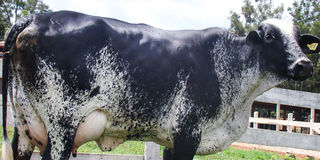How Kenya could get more beef from the dairy sector
Sponsored by Kenya Meat Commission

What you need to know:
- Beef farmers can take advantage of cull cows to produce animals that will yield high-quality meat.
- Research shows that young healthy cull cows can eat between 2.5 to 4 percent of their body weight per day, and gain an average weight of 1.8kg daily.
- The result will be cows that have an improved carcass weight, increased dressed weight, tenderness, marbling fat, and good quality fat cover.
Kenya has an estimated population of 21 million head of cattle. Out of these 16.4 million are beef cattle, mainly kept by pastoralists in the arid and semi-arid lands, popularly referred to as ASALs. Most of the remaining 4.6 million dairy cattle are reared in high-potential areas.
Local pastoral cattle herds in Kenya provide about 56 percent of the national beef supply. Herds from neighbouring countries add about 15 percent of the beef consumed in the country. Dairy herds contribute about 25 percent, and the rest come from ranches, feedlots and some imports, mainly to serve the quality-sensitive markets.
It is estimated that an average Kenyan consumes about 10kg of beef in a year. Based on the estimated national population of about 52 million, the total annual beef consumption works out to about 520 million kilos. To meet this supply, the country needs to slaughter 3.5 million cattle annually, which is 16 percent of the total beef herd.
Kenya is just emerging from severe drought seasons, with most pastoralists in the ASAL counties having lost a significant portion (about 15 percent) of their herds. It will take a while for them to rebuild their stocks. This means that most butcheries and meat processors are now dependent on cattle from the highland areas, which are mainly dairy breeds. Many of these are exotic breeds, bred and managed for high milk production. For this reason, dairy cows are generally poor meat producers compared to beef breeds.
Dairy farmers cull between 800,000 and one million head of cattle for meat production every year, earning them between Ksh30-40 billion. They cull for various reasons, which include a decrease in milk production, poor health, old age, severe injury resulting from farm mishaps, and infertility.
Dairy farmers are reluctant to invest more on cull cows or bull calves because, to them, such investment is a loss. Consequently, dairy cows presented to the livestock markets are always in poor body condition with low body scores. The animals look very thin with little or no fat cover, and little muscling. Some of the cows are also very old, leading to production of poor-quality meat with a low dressing weight (weight of meat at slaughter), which is often between 32 percent and 48 percent of the animal’s initial body weight.
As a result, most butcheries and meat processors shun dairy cows or bulls, or offer very low prices for them, yet they have the potential to earn farmers good returns if well managed after culling. This is because cull cows and bulls from dairy farms are able to gain weight very rapidly as compared to beef cattle (compensatory growth or weight gain), and can give farmers better returns in the market and meat processors another profitable source for producing prime meat cuts.
Culling at the appropriate time ensures the cows are healthy when entering the food cycle, and secures a good salvage value. Beef farmers can take advantage of the cull cows to produce animals that will yield high-quality meat. This can be done through selection of good cull cows for feedlotting. The cows should be healthy, young, not pregnant, have no visual defects, and have a good body frame with a low body score to take advantage of the compensatory weight gain.
The selection should take into account the body condition and the muscle scores. For the farmers to choose the best, they need to work with extension officers and animal health personnel.

A section of the Kenya Meat Commission plant in Athi River.
The selected animals will then need to be put in feedlots or improved pasture for about 70 days, or until they achieve the desired body and muscling score. Research shows that young healthy cull cows can eat between 2.5 to four percent of their body weight per day, and gain an average weight of 1.8kg daily. The result will be cows that have an improved carcass weight, increased dressed weight, tenderness, marbling fat, and good quality fat cover. The fat colour will change from yellow to white.
Policymakers, researchers, and other stakeholders in the beef sector therefore need to move with speed and tap this enormous potential and multibillion-shilling opportunity offered by the dairy sector. This can offer employment opportunities for the youth, with the support of national and county governments through funding, facilitation on the use of community land for setting up feedlots and pasture production, and provision of other agricultural incentives.
Research should therefore be directed towards finding the most suitable beef production system for the exotic dairy cattle breeds and lowering the cost of production of meat from the exotic dairy bulls to make the venture attractive and profitable. This is because most of the bull calves are culled from commercial dairy farms when they are days old. The milk consumed by the dairy bull calves is deemed a loss, and research on affordable alternative feed sources should be a priority, so as to reduce the costs of raising bull calves.
A strategy to promote value-based marketing for beef cattle where the pricing system incentivises farmers to produce quality beef cattle for the markets will also drive the production of high-quality beef cattle for the local and international markets. This is expected to be a top agenda for the government and stakeholders, who are in the process of preparing a master plan and strategy for the beef industry in the country.


